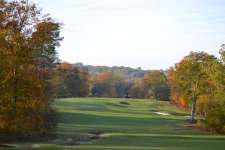An example of the patience needed to create good golf, Grand Saint Emilionnais Golf Club was the vision of the prominent Mourgue d’Algue family and took more than a dozen years from conception to reality. Set amid the pristine vineyards of Bordeaux’s ancient Saint-Émilion wine district, the course is situated on a wooded 250-acre estate in the town of Gardegan. It was first discovered by family patriarch Gaëtan and his son André in 2003. After purchasing the property and receiving planning consent for a David McLay Kidd routing, the family sold the project to an international developer shortly before the Global Financial Crises of 2008. They later bought it back at a reduced price, and committed to building the golf course themselves. Rather than use Kidd, however, they decided to engage American Tom Doak instead.
What attracted the famous French golfing family to this property all those years back were a number of important development factors. First there was the location, unmatched in southern France for its proximity to the divine UNESCO World Heritage listed village of Saint-Émilion. The land itself was quite charming, and perfect for the private golfing enclave they sought to create. Beyond some gentle undulations and natural watercourses, lay the ruins of a 19th century Château and a number of old stone outbuildings and barns. There was also a beautiful collection of mature trees, including birch, native Bordeaux Pines and numerous 100-year old oaks.
Without being overly dramatic, Doak’s canvas here was somewhat diverse and more than reasonable for interesting golf. His great routing achievement was being able to capture the essence of the region by tiptoeing delicately across a variety of landforms. From the broad side slopes of the early holes to the hills and ridges through the middle section and the wandering creeks and ditches, his use of the native terrain and the natural features is outstanding.
After a slightly lifeless starting run, the strength of Saint Emilionnais is the middle stretch of holes, revealed once golfers traverse an abrupt hill on the par five 5th. With a strong British flavor, this area is especially fun and playable to members on a repeated basis. The neighboring 6th and 7th holes standout for their attractive green sites and use of a broad rolling ridge, while the 8th is a terrific short par four bunkered to be more complicated for those playing too safely from the tee. A necessary evil, the 9th then plays down across an irrigation lake to an adventurously contoured green with all sorts of wild pins and putts.
The sequence of quality holes continues on the back nine, with the gently bending 10th spacious enough to entice the aggressive approach and the 11th played over a ridge and down toward a green surface that many golfers won’t see from the fairway. The front section of this target is essentially a shallow half-pipe, the tumbling approach somewhat reminiscent of the famous Perfection hole from North Berwick in Scotland. The par three 14th and downhill diagonal cross-creek approach into the 13th hole also work well.
Doak likes to pay tribute to famous holes and courses in his work, and with the unsuitable clay base, roving creek, undulations and mix of established hardwoods there were shades of Augusta National here in France. Not surprisingly, there exist a couple of strong Augusta-esque moments as well. The most obvious is the unusual green setting on the 15th hole, its putting surface surrounded by large pop-up mounds, and the elegantly bending tee shot on the 17th, which resembles the famous 13th at Augusta for the creek hugging the left side of the fairway and the higher hanging lies that await those driving too straight or too far up the right-hand side. The green here is a study in simplicity, partly hidden by a gentle mound it's no torture test but confounding enough to lull sloppy golfers into a simple bogey.
Across the course Doak’s bunkering has a naturalistic feel and is generally used quite sparingly. His green contours, on the other hand, are rather brash. As a set, these are among the most daring inland greens in Europe. Like a good red wine, Saint Emilionnais is sure to age well and mature as the years progress. While some of Tom Doak’s design features might be a little subtle for French sensibilities, this is a fine members course and a lovely place to belong. The fact the owning family plans to encourage outside play only enhances its appeal.

 this course also has exceptional:
this course also has exceptional:




